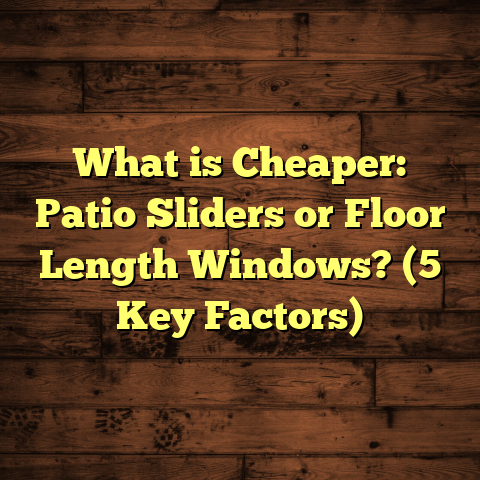What is Elegant Hardwood Flooring? (5 Reasons It Stands Out)
Nostalgia hits me hard whenever I walk into a house with hardwood floors. It takes me back to my childhood home, where the oak planks stretched across every room, catching the sunlight in that warm, golden way only wood can. Those floors were more than a foundation beneath my feet — they held memories. From the sound of my sneakers squeaking during hide-and-seek games to the quiet moments when I sat reading by the window, those floors were part of my story. If you’ve ever felt that pull toward something timeless and classic in your home, you’ll understand why I’m so passionate about elegant hardwood flooring.
Over the years, I’ve worked with countless clients, installed hundreds of floors, and studied the nuances of wood that make a floor not just good but elegant. So, what exactly is elegant hardwood flooring? Why does it stand out so much from other options? And more importantly, how can you bring that elegance into your own space with confidence?
Let’s talk about all of that.
What Is Elegant Hardwood Flooring?
Elegant hardwood flooring isn’t just any wooden floor. It’s about choosing quality materials, expert craftsmanship, and finishes that bring out the natural beauty of wood in a way that feels both refined and inviting.
When I say hardwood flooring, I mean floors made primarily from solid wood species like oak, maple, cherry, or walnut. There’s also engineered hardwood, which has a real wood veneer over a plywood base — offering stability without sacrificing the look and feel of solid wood.
But elegance? That’s where detail matters.
Elegant hardwood flooring shows:
- Natural Grain & Color: The wood’s unique patterns and colors are vivid and thoughtfully selected.
- Smooth Finish: The surface is polished or matte-finished to perfection to highlight wood’s texture.
- Durability: It stands up to years of foot traffic while maintaining its charm.
- Timeless Appeal: It complements any interior style — from classic to contemporary.
I’ve been a flooring contractor for over a decade, and I can tell you — when you see a truly elegant hardwood floor, it grabs your attention in a way that vinyl or laminate just can’t. It invites you to touch it, to imagine life lived on it.
Why Hardwood?
Wood interacts with light differently than synthetic materials. It absorbs warmth visually and physically. It changes with seasons and age — developing character over time. That’s the magic of hardwood.
But enough about theory — let me share some stories and facts that really show why elegant hardwood floors stand out.
1. Natural Beauty That Changes With Time
One thing I always tell clients is this: if you want floors with personality, go natural. Hardwood floors have grains and hues that tell a story no two planks share.
The Wood’s Story
Each plank is like a fingerprint — unique and full of history. How the tree grew influences the grain patterns — tight rings from slow growth or wide waves from fast growth. The color can range from pale blondes to deep reds and browns depending on species and cut.
For example:
- Oak offers classic grain with warm tones.
- Maple is smooth with lighter shades.
- Cherry darkens beautifully over time.
- Walnut is rich and dramatic.
I worked on a restoration project recently where the homeowners chose reclaimed oak flooring. The boards had knots, nail holes, even old saw marks — imperfections that added authenticity and charm. After refinishing the floor, it looked like it had been there for centuries but was fresh enough for everyday living.
The Patina Effect
Hardwood ages like fine wine. Over time it develops a patina — a soft sheen caused by natural wear and exposure to light.
One study tracked the color changes in cherry hardwood over 10 years and found up to a 15% deepening in hue. This aging process adds warmth and richness that no stain or finish can replicate artificially.
Data Backing Beauty
Homes with hardwood flooring sell 2-5% higher than comparable homes without it according to multiple real estate reports. Buyers associate hardwood with quality and style.
In my experience installing floors for resale properties, homes with elegant hardwood often spend less time on the market because they “feel” more inviting immediately.
Tips for Enhancing Natural Beauty
- Choose wood species known for attractive grain patterns.
- Opt for wider planks to showcase natural variation.
- Avoid overly glossy finishes that mask texture.
- Consider hand-scraped or wire-brushed textures for added character.
2. Longevity That Outlasts Trends
When I talk to clients about flooring options, one of the biggest questions is: “How long will this last?”
Here’s what I tell them: Hardwood floors can easily last over 100 years when cared for properly. That’s not an exaggeration — I’ve seen century-old floors in historic homes still going strong with some refinishing.
Real-Life Example
I recently helped renovate a 1920s farmhouse where the original pine hardwood was hidden under layers of carpet and linoleum. After careful sanding and refinishing, those floors looked almost brand new again.
The beauty of hardwood is that you can refinish it multiple times — sanding down scratches or stains and applying fresh coats of finish restores its appearance without replacing planks.
Engineered Hardwood Durability
For areas prone to moisture (kitchens, basements), engineered hardwood offers stability without sacrificing elegance. Its plywood core resists expansion better than solid wood but still showcases real wood tops.
Cost Perspective
While hardwood upfront costs are higher than vinyl or laminate (average $8-$15 per square foot versus $2-$5), its lifespan means fewer replacements over time, potentially saving money in the long run.
Tips for Longevity
- Maintain proper humidity levels (35%-55%) to prevent wood warping.
- Use area rugs in high-traffic zones.
- Refinish every 7-10 years or as needed.
- Address spills immediately to avoid stains.
3. Versatility in Style and Design
If you think hardwood floors are just “brown planks,” think again. I love showing clients how flexible hardwood can be for expressing style.
Wood Species & Colors
There’s a huge palette to choose from:
- Light hues like maple or ash brighten rooms.
- Medium tones like hickory add warmth.
- Dark woods like walnut bring drama.
A recent industry survey showed walnut floors grew in popularity by 12% last year due to their rich look.
Finishes & Textures
Finish choices drastically change how floors feel:
- Matte finishes offer a modern, understated look.
- Satin finishes balance shine and softness.
- Glossy finishes reflect light for a polished effect.
Texturing options include:
- Hand-scraped: Adds rustic charm.
- Wire-brushed: Enhances grain texture.
- Smooth: Classic elegance.
Plank Widths & Patterns
Wider planks are trending, giving rooms an open feel. Narrower strips offer traditional appeal.
Patterns like herringbone or chevron add visual interest beyond straight planks. I recently installed herringbone oak floors for a client who wanted classic style with a twist — it took the room from ordinary to extraordinary.
Customization Tips
- Mix plank widths for unique looks.
- Use contrasting borders for definition.
- Match stain color to existing wood trim or cabinetry.
4. Easy Maintenance That Saves Time and Money
Many people hesitate thinking hardwood is high maintenance or easily damaged. From what I’ve seen over thousands of square feet installed, that’s not true if you follow some simple habits.
Routine Cleaning
Sweep or vacuum regularly using soft bristle tools to keep grit off the surface. A microfiber mop with wood floor cleaner works wonders without leaving residue.
Preventing Damage
Furniture pads prevent dents. Area rugs at entrances reduce dirt tracked inside.
Avoid harsh chemicals or excessive water which can dull finishes or cause warping.
Repair & Refinishing
Minor scratches can be buffed out or touched up with stain markers. When damage accumulates, sanding removes surface imperfections before applying new finish coats.
Cost Benefits
According to the NWFA (National Wood Flooring Association), homes with well-maintained hardwood spend about 30% less on floor repairs over 10 years compared to carpeted homes which often require replacement every 7-10 years.
My Maintenance Routine
I tell clients:
- Sweep daily or every other day in busy areas.
- Mop once a week or as needed with recommended products.
- Avoid walking barefoot outside on hardwood floors; dirt acts like sandpaper.
5. Adds Real Value to Your Home
Hardwood floors are one of the best investments you can make in your home’s market value.
ROI Statistics
Remodeling Magazine reports hardwood flooring projects recover up to 70-80% of costs upon resale — one of the highest ROI figures among home upgrades.
Additionally:
- Zillow analytics show homes with hardwood floors sell faster by an average of two weeks.
- Buyers express higher satisfaction levels when viewing properties with hardwood rather than carpet or tile.
Emotional Impact
I’ve had clients tell me after installing cherry floors that their home feels “warmer,” “more inviting,” and even “luxurious.” This emotional connection often translates into better offers from buyers who see the home as move-in ready and cared-for.
Strategic Installation
If budget is limited, prioritize installing hardwood in main living spaces like living rooms, kitchens, or entryways where it makes the biggest impression.
Personal Story
I worked with a young couple upgrading their first home on a budget. We installed engineered oak floors in their main areas while keeping bedrooms carpeted for comfort. They later told me it transformed their space without blowing their savings — they felt proud welcoming guests every day.
Additional Insights From My Experience
Beyond these five reasons, here are some lesser-known but important points I’ve learned from years on job sites:
Environmental Impact & Sustainability
Many clients ask me about eco-friendliness. Hardwood is renewable if sourced responsibly from managed forests certified by FSC (Forest Stewardship Council).
Choosing reclaimed wood also reduces environmental footprint while adding character.
Allergies & Indoor Air Quality
Hardwood doesn’t trap dust mites or allergens like carpet does — great news if someone in your household has allergies or asthma.
Comfort & Warmth Underfoot
While tile can feel cold, hardwood maintains a comfortable temperature year-round especially when paired with area rugs or radiant heating systems.
Installation Considerations
Proper subfloor preparation is key to avoid squeaks or uneven planks down the road. Hiring an experienced installer makes all the difference — trust me on this one!
My Step-by-Step Recommendations for Choosing Elegant Hardwood Flooring
If you’re thinking about installing elegant hardwood flooring yourself or hiring someone, here’s what I advise:
- Assess Your Lifestyle: Do you have pets? Kids? High foot traffic?
- Choose Wood Species: Harder woods like oak or maple resist dents better.
- Decide Between Solid vs Engineered: For below-grade areas, engineered is safer.
- Pick Finish & Texture: Matte finishes hide scratches; glossy looks sharper but shows wear more.
- Plan Installation Pattern: Straight plank for simplicity; herringbone or chevron for flair.
- Set Budget: Hardwood varies widely; set realistic expectations including installation costs.
- Hire Skilled Installer: Experience prevents costly mistakes.
- Maintain Properly: Follow cleaning tips religiously.
- Enjoy Your Floors: Use area rugs wisely; embrace natural aging patina over time.
Final Thoughts From Me
Elegant hardwood flooring has been part of my life professionally and personally for years now. It’s not just flooring — it’s an expression of care for your home that pays dividends in beauty, comfort, durability, and value.
Whether you’re renovating an old home or building new, adding hardwood floors can transform your space into something special you’ll cherish daily — just like those oak planks from my childhood home did for me.
If you want advice tailored to your project or help choosing materials based on your needs, I’m here anytime to chat about making your floors both elegant and lasting.
Would you like me to include specific recommendations for wood species based on climate or lifestyle? Or perhaps installation cost breakdowns based on region? Just let me know!





